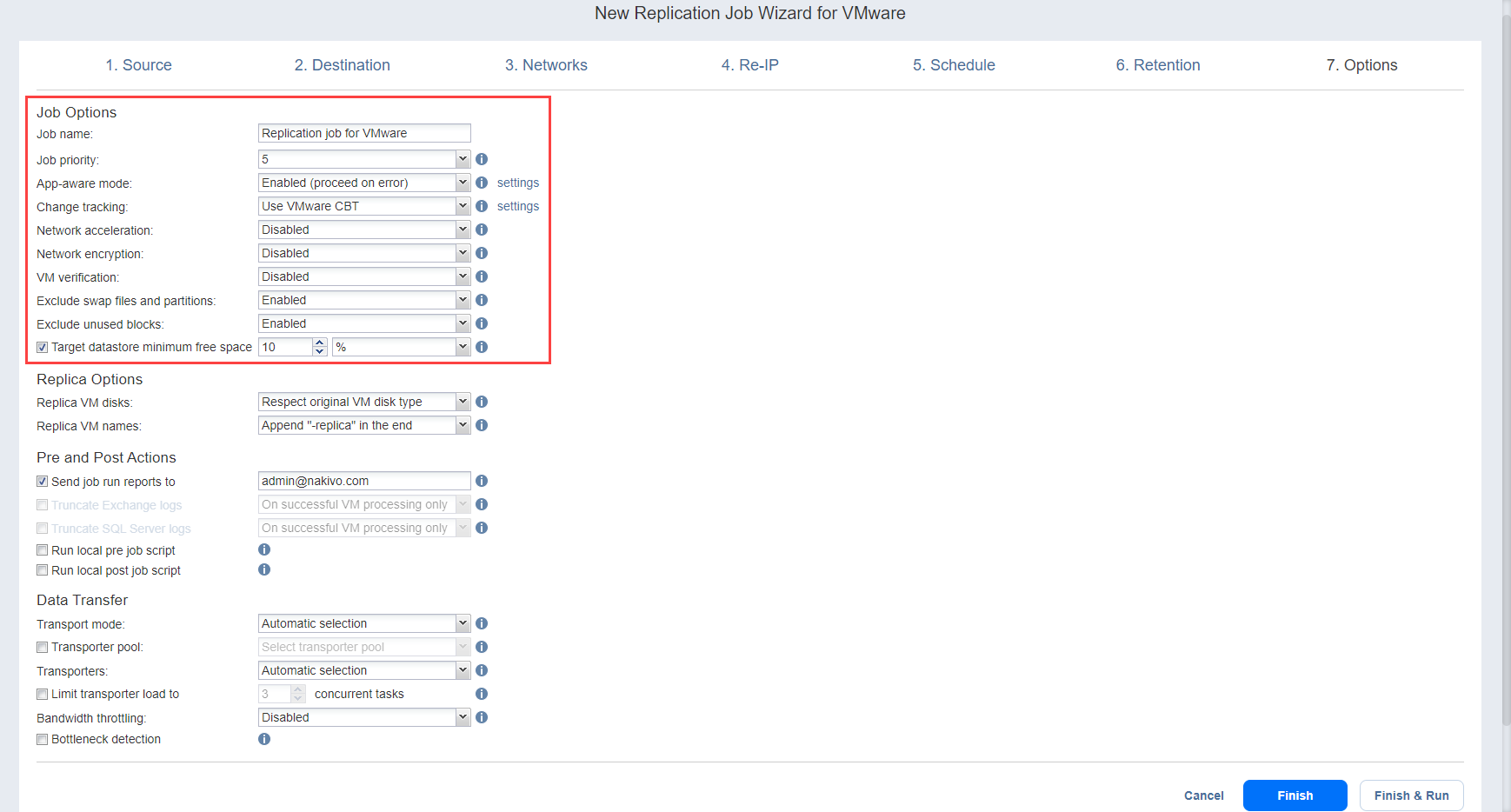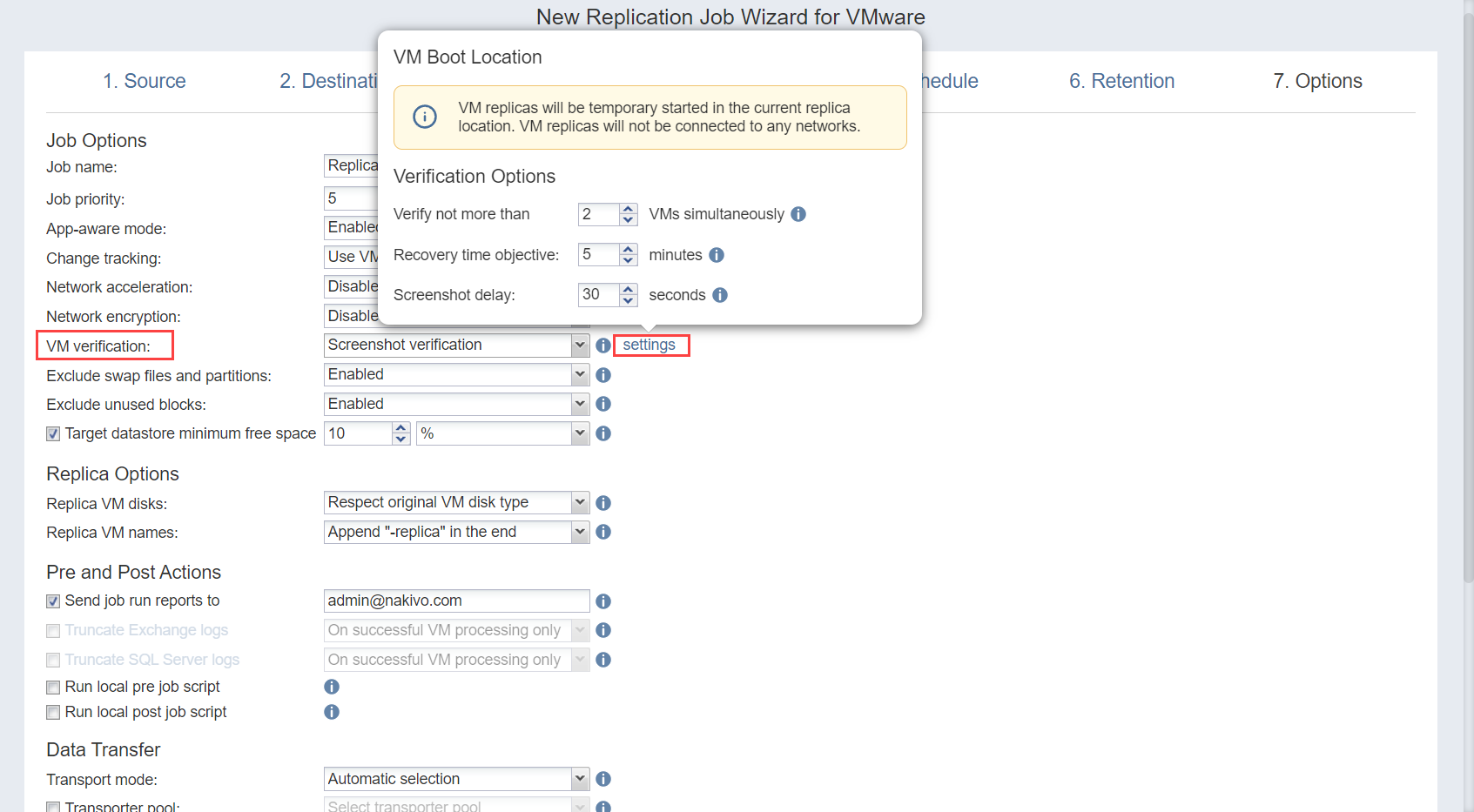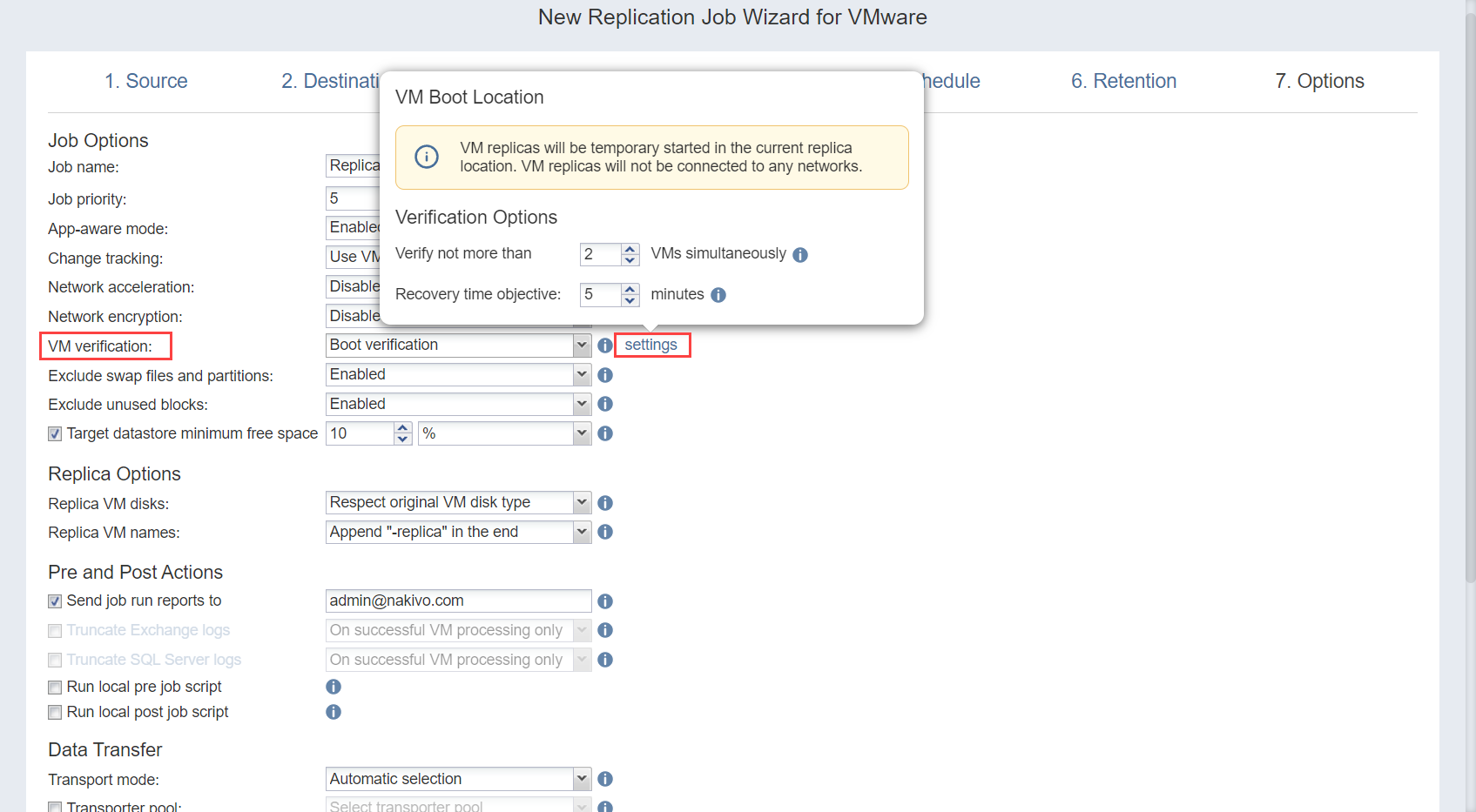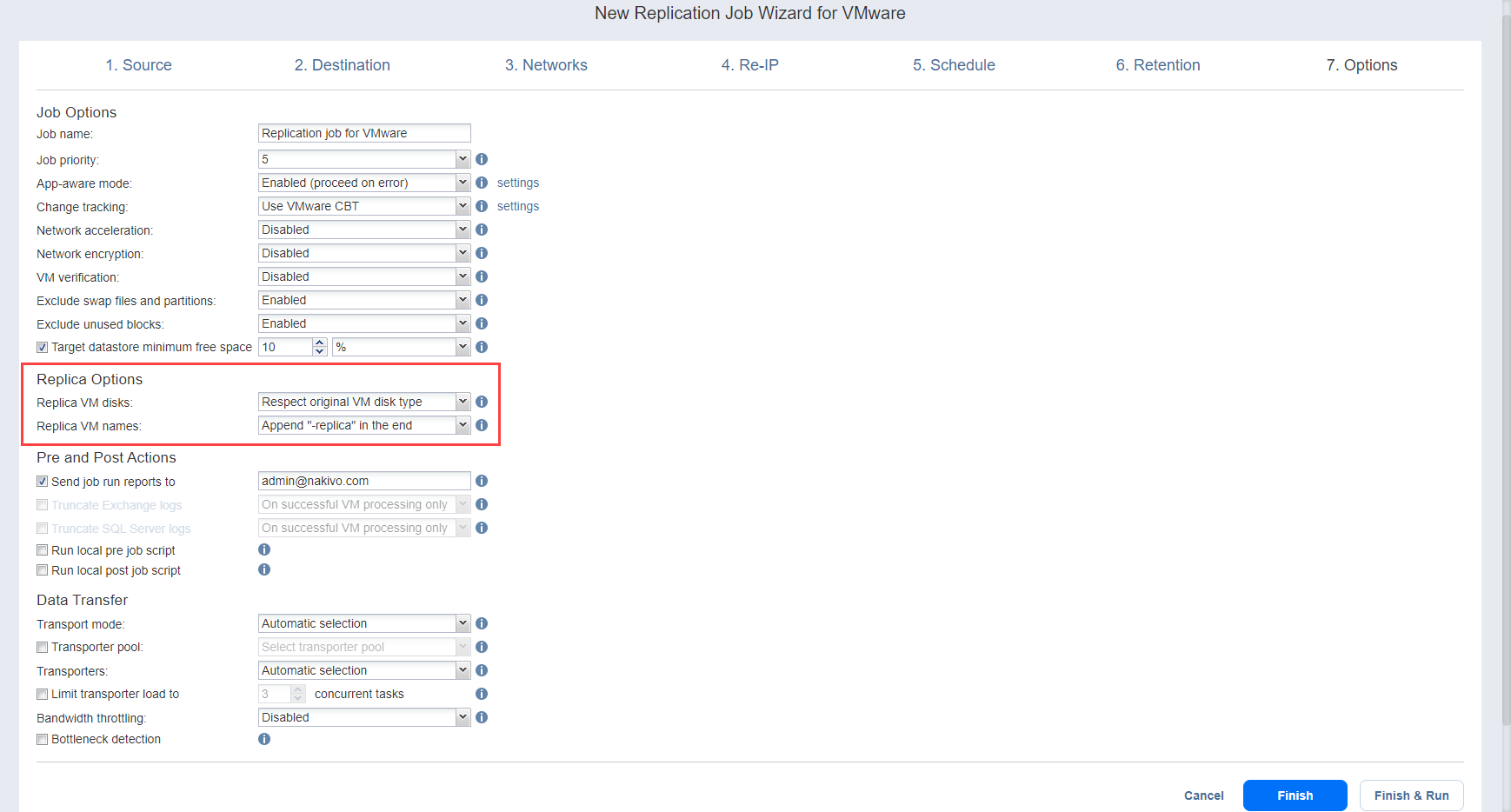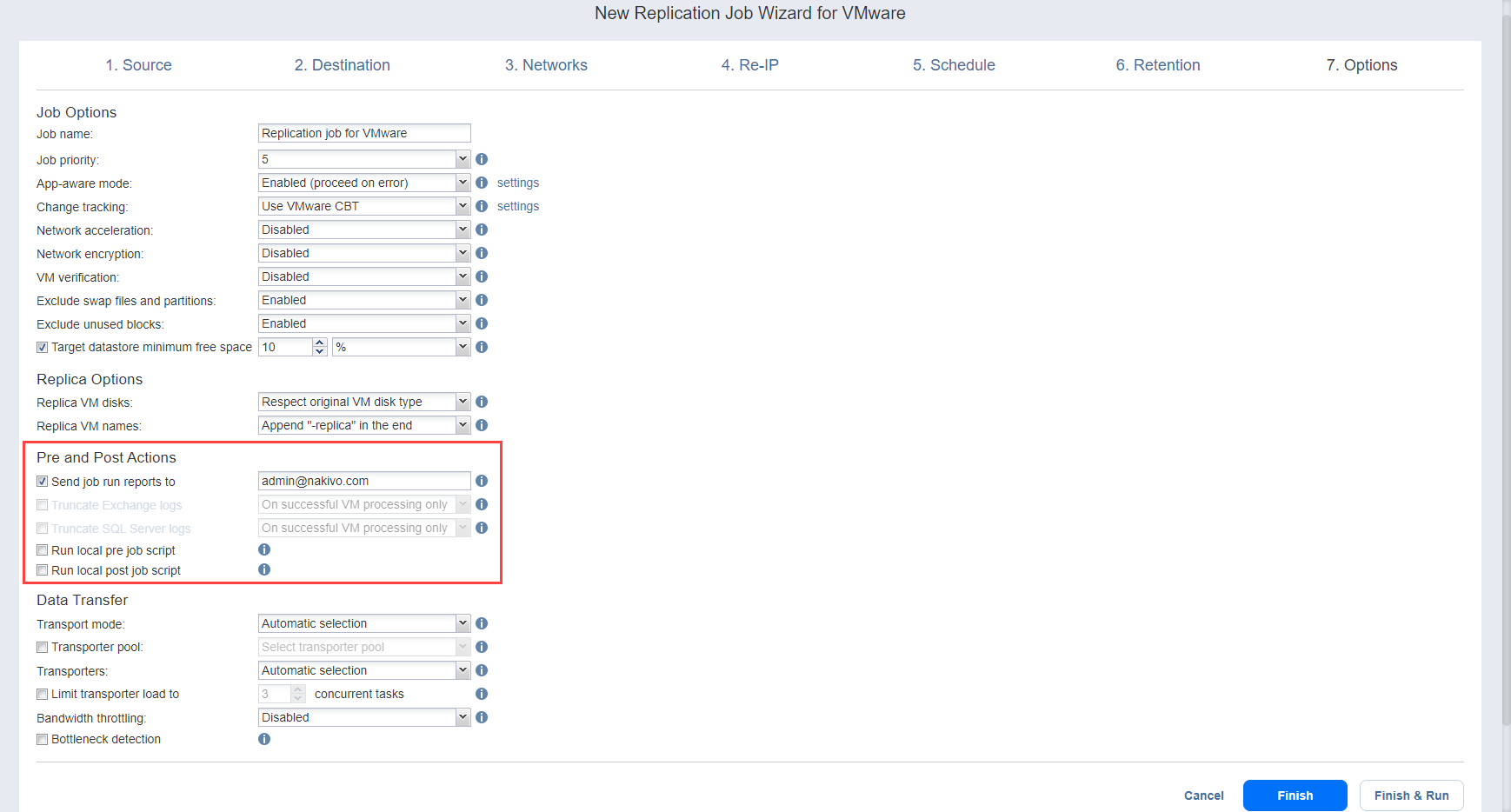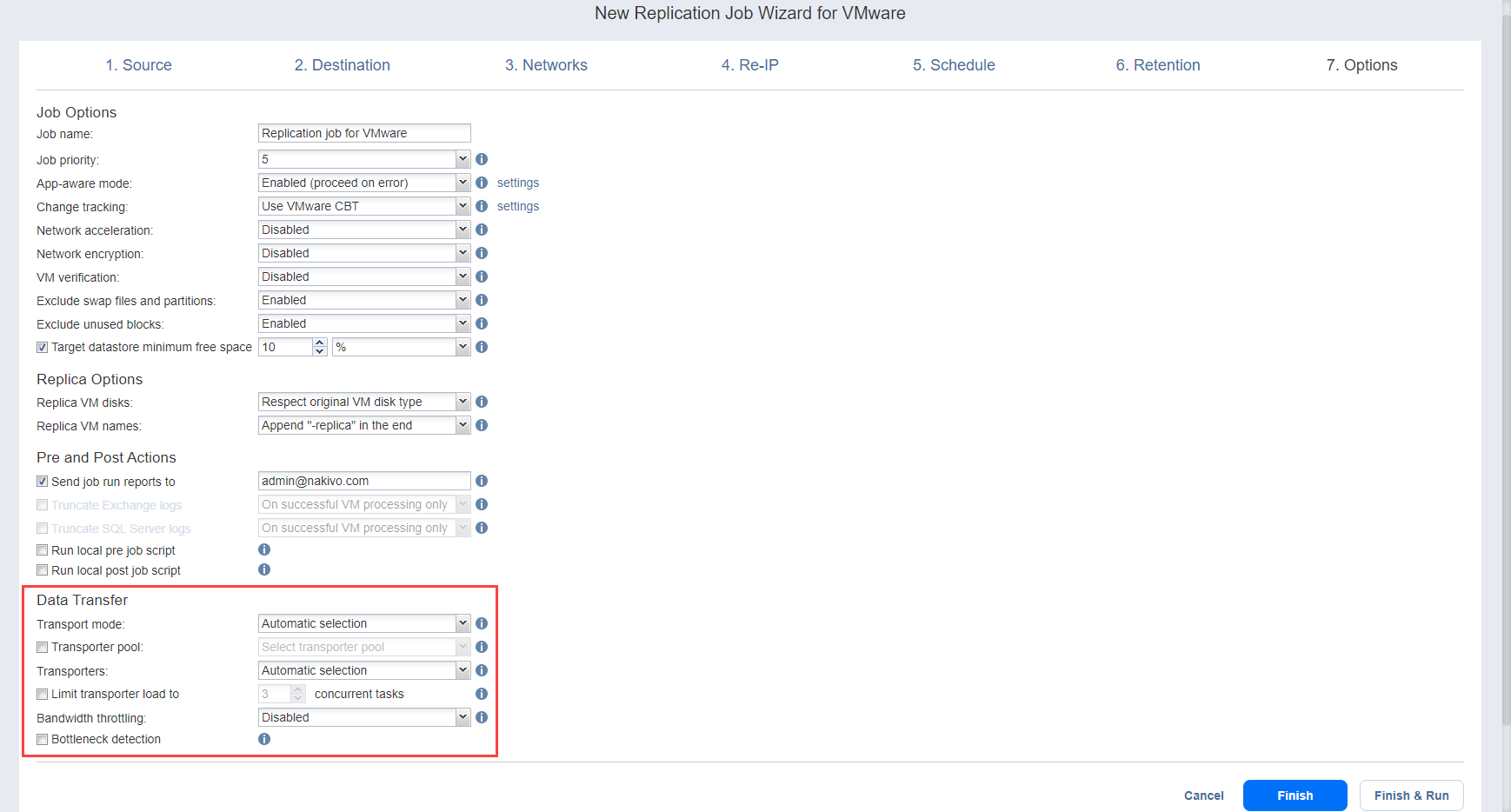Replication Job Wizard for VMware: Options
On the Options page, set up replication job options as described in the sections below:
Job Options
In this section, you can specify a name and a priority level for your replication job, and enable/disable app-aware mode, change tracking, network acceleration, encryption, VM Verification, and excluding swap files, partitions and unused blocks.
Job Name
Specify a name for the replication job.
Job Priority
Select a job priority level between 1 and 5, with 1 being the highest priority. Jobs with higher priority levels are prioritized by Transporters during job processing.
Note
This option is only available in the Enterprise, Enterprise Essentials, Enterprise Plus, MSP Enterprise, and MSP Enterprise Plus editions.
App-aware Mode
With the App-aware mode selected, VM replication is performed using VMware Guest OS quiescing (which in turn relies on Microsoft VSS) to ensure the consistency of application data. Select one of the options from the Change tracking drop-down list:
-
Enabled (proceed on error): With this option selected, NAKIVO Backup & Replication proceeds even if an application quiescing error is encountered.
-
Enabled (fail on error): With this option selected, NAKIVO Backup & Replication automatically fails the job if an application quiescing error is encountered.
-
Disabled: Selecting this option disables the app-aware mode.
Note
This option is not available for existing backups chosen as the target of replication on the Source wizard page.
Change Tracking
Select one of the options from the Change tracking drop-down list:
-
Utilize VMware CBT: With this option selected, NAKIVO Backup & Replication enables the Change tracking feature for source VMs. This feature quickly identifies which data blocks have changed since the last job run, significantly increasing job speed. Click settings to specify the following options:
-
On error:
-
switch to proprietary method immediately/on the next retry/on the last retry: If VMware CBT fails to provide data on changed blocks for a VM with this option selected, NAKIVO Backup & Replication performs an incremental backup of the VM using the proprietary change tracking technology.
-
reset CBT on the next retry/on the last retry: If VMware CBT fails to provide data on changed blocks for a VM with this option selected, NAKIVO Backup & Replication resets VMware CBT for the VM.
-
fail VM processing immediately/on the next retry/on the last retry: If VMware CBT fails to provide data on changed blocks for a VM with this option selected, NAKIVO Backup & Replication does not process the VM and states job failure (other VMs in the job are processed).
-
Double-check changed blocks provided by CBT: With this option selected, NAKIVO Backup & Replication runs a check on data blocks provided by VMware CBT to ensure that VMware CBT does not overstate the amount of changed data.
-
-
-
Use proprietary method: With this option selected, NAKIVO Backup & Replication performs incremental backups using the proprietary change tracking technology. This feature requires reading the contents of all VM disks to determine the data blocks that have changed since the last job run.
-
No change tracking (always full): With this option selected, NAKIVO Backup & Replication always performs a full VM backup of all source VMs.
Note
This option is not available for existing backups chosen as the target of replication on the Source wizard page.
Network Acceleration
With Network acceleration enabled, NAKIVO Backup & Replication uses compression and traffic reduction techniques to speed up data transfer. Select this option if you plan to replicate over WAN or slow LAN links.
Network Encryption
If Network Encryption is enabled VM data is protected with AES 256 encryption while traveling over the network. Data encryption increases the replication time and CPU load on machines running Transporters. Select this option when replicating over WAN without a VPN connection.
Note
You need at least one Transporter at source and target sites to enable encryption.
VM Verification
VM Verification allows you to check the integrity of the backup by starting it and interacting with it. For more details, refer to the VM Verification article.
You can choose one of the following VM Verification options:
-
Disabled: VM Verification is disabled.
-
Screenshot verification: When enabled, the VM replica created by the job is verified: NAKIVO Backup & Replication powers on this replica with networking turned off, takes a screenshot of the OS, then powers off the VM replica. The VM screenshot will be included in email notifications (if they’re configured. See Notifications & Reports.) and displayed on the Dashboard.
-
Boot verification: When enabled, the VM replica created by the job is verified: After VM replication is completed, NAKIVO Backup & Replication recovers the VM using Flash boot, disables networking to prevent network connections, and verifies that system start is successful.
Important
VM verification requires VMware Tools to be installed on all VMs.
After selecting the Screenshot verification option, do the following in the dialog box that opens:
-
Verify not more than x VMs simultaneously: Specify the maximum number of VMs that can be started on the target container simultaneously.
-
Recovery time objective x minutes: Specify the amount of time allocated for verification of each VM backup. If a VM OS does not start within the specified amount of time, verification will be considered failed.
-
Screenshot delay x seconds: The amount of time that the product should wait after the Guest OS starts before taking a screenshot.
Note
The specified time must be sufficient to fully start the VM OS. Try increasing this amount if the default amount is not sufficient.
-
Provide a location of the VMs to be booted as described for the Screenshot verification option.
-
Set verification options:
-
Verify not more than x VMs simultaneously: Specify the maximum number of VMs that can be started on the Target Container simultaneously.
-
Recovery time objective: Specify the amount of time allocated for verification of each VM backup. If a VM OS does not start within the specified amount of time, verification will be considered failed.
-
Exclude Swap Files and Partitions
When this option is enabled, NAKIVO Backup & Replication automatically excludes swap files and partitions during the backup process.
Note
This feature is not available for replication from backup jobs.
Exclude Unused Blocks
When this option is enabled, NAKIVO Backup & Replication automatically excludes unused disk blocks and blocks occupied by deleted files during processing of source objects running Windows OS. This feature allows for reducing backup storage space and object processing time.
Note
This feature is not available for replication from backup jobs.
Target Datastore Free Space
With this option enabled, specify the minimum free space for the target datastore during incremental job run. In case the free space on the target datastore is below the set value, the job automatically fails.
Replica Options
In this section, you can choose a VM disk type and VM name. Proceed as described below.
Replica VM Disks
Choose one of the following options:
-
Respect original VM disk type: With this option enabled, the created disk will be of the same type as that of the source VM.
-
Create only thin disks on target VMs: With this option enabled, only thin disks are created on replicas, regardless of the disk types of the original source VM.
Replica VM Names
NAKIVO Backup & Replication allows you to change VM Replica names to easily distinguish between the VM Replicas and the source VMs. By default, the text “-replica” is appended to the end of the VM Replica name.
To change VM Replica names:
In the Replica Options section, choose one of the following Replica VM names options:
- Append “-replica” in the end: Source VM names are used for replica names and “-replica” are added to the replica name.
- Leave replica names as is: Replica names will be identical to the source VM names.
- Enter custom replica names: Enter custom names for replicas.
Pre and Post Actions
In the Pre and Post Actions section, you can set up email notifications, Exchange and SQL Server logs truncation, pre and post job scripts.
Email Notifications
NAKIVO Backup & Replication can send email notifications about the job completion status to specified recipients. This feature complements global notifications and allows you to configure notifications on a per-job level.
Note
To enable this option, make sure your Email settings are configured.
To send email notifications, do the following:
In the Pre and Post Actions section:
-
Select Send job run reports to.
-
Specify one or more email addresses in the text field. Use semicolons to separate multiple email addresses.
Microsoft Exchange Server Logs Truncation
NAKIVO Backup & Replication allows you to delete (aka truncate) Microsoft Exchange Server logs on the source VMs after job completion.
To set up Microsoft Exchange log truncation, do the following:
-
In the Pre and Post Actions section, select the Truncate Exchange logs option.
-
In the Exchange Log Truncation dialog box that opens, select the checkboxes next to the VMs running Microsoft Exchange and then select the credentials next to each VM. These credentials are used to log into the VMs that you have selected.
Note
This option is not available for existing backups chosen as the target of replication on the Source wizard page.
Microsoft SQL Server Logs Truncation
NAKIVO Backup & Replication allows you to delete (aka truncate) Microsoft SQL Server logs on the source VMs after job completion.
To set up Microsoft SQL log truncation, do the following:
-
In the Pre and Post Actions section, select the Truncate SQL Server logs option.
-
In the SQL Server Log Truncation dialog box that opens, select the checkboxes next to the VMs running Microsoft SQL Server and then select the credentials next to each VM. These credentials are used to log into the VMs that you have selected.
Note
This option is not available for existing backups chosen as the target of replication on the Source wizard page.
Pre Job Script
To run a script before the product begins replicating VMs:
-
Place a script file on the machine where the Director is installed.
-
In the Pre and Post Actions section, select the Run local pre job script option.
- Script path: Specify a local path to the script on the machine where the Director is installed. Script interpreter should be specified.
-
Example (Windows): cmd.exe /c D:\script.bat
Example (Linux): bash /root/script.sh
-
Job behavior: Choose one of the following job behaviors in relation to script completion:
-
Do not wait for the script to finish: With this option selected, the product runs the script and starts replicating VMs at the same time.
-
Wait for the script to finish: With this option selected, VM replication is started only after the script is completed.
-
-
Error handling: Choose one of the following job behaviors in relation to script failure:
-
Fail the job on script failure: With this option selected, the job is failed and VM replication is not performed if the script has failed.
-
Continue the job on script failure: With this option selected, the job performs VM replication even if the script has failed.
-
Specify the following parameters in the dialog box that opens:
Post Job Script
To run a script after the product has finished backing up all VMs:
-
Place a script file on the machine where the Director is installed.
-
In the Pre and Post Actions section, select the Run local post job script option.
-
Specify the following parameters in the dialog box that opens:
-
Script path: Specify a local path to the script on the machine where the Director is installed. Script interpreter should be specified.
Example (Windows): cmd.exe /c D:\script.bat
Example (Linux): bash /root/script.sh -
Job behavior: Choose one of the following job behaviors in relation to script completion:
-
Wait for the script to finish: With this option selected, the job is in the “running” state until the script is completed.
-
Do not wait for the script to finish: With this option selected, the job is completed even if the script execution is still in progress.
-
-
Error handling: Choose one of the following job behaviors in relation to script failure:
-
Continue the job on script failure: With this option selected, script failure does not influence the status of the job.
-
Fail the job on script failure: With this option selected and the script has failed, the job status will be set to “failed” even if VM replication has been successful.
-
-
Data Transfer
In the Data Transfer section, you can choose a transport mode and a Transporter to be used for reading data from source VMs, and configure bandwidth throttling. Proceed as described below.
Transport Mode
To select a transport mode, in the Data Transfer section, choose a transport mode for retrieving VM data:
-
Automatic selection: With this option selected, NAKIVO Backup & Replication automatically selects the best transport mode available:
-
If the source Transporter is installed on a VM, NAKIVO Backup & Replication tries to use transport modes in the following order: Hot Add > SAN > LAN.
-
If the source Transporter is installed on a physical machine, NAKIVO Backup & Replication tries to use transport modes in the following order: SAN > Hot Add > LAN.
-
-
SAN only: With this option selected, NAKIVO Backup & Replication only uses direct SAN access to retrieve VM data. If direct SAN access to VM data is not available, the job will fail.
-
Hot Add only: With this option selected, NAKIVO Backup & Replication only uses Hot Add to retrieve VM data. If direct Hot Add is not available, the job will fail.
-
LAN only: With this option selected, NAKIVO Backup & Replication only retrieves VM data via LAN.
Note
This option is not available for existing backups chosen as the target of replication on the Source wizard page.
Transporter Pool
If this option is enabled, only the transporters that belong to the selected transporter pool shall be used during the job run.
Transporters
By default, the product automatically determines the Transporter to be used to read data from the source VM. However, you can manually specify the Transporters to be used for the job by choosing one of the following Transporters options in the Data Transfer section:
-
Automatic selection: The product automatically determines the Transporters that are the closest to source and target hosts.
-
Manual - configured for all VMs: Select this option to manually specify a single source and a single target Transporter to be used for data transfer by the job.
-
Manual - configured per host: Select this option to manually specify Transporters for all source and target hosts.
Transporter Load
You can limit the maximum number of transporter tasks used by the job. By default, it is set to 3 concurrent tasks.
To change the default number of tasks, do the following:
-
In the Data Transfer section, select the checkbox next to Limit transporter load to.
-
Specify the number of concurrent tasks in the corresponding field.
Bandwidth Throttling
To regulate the speed of data transfer over the network for your replication job:
-
For the Bandwidth throttling option, choose Enabled.
Note
If bandwidth throttling is disabled for the current job, global bandwidth rules may still apply to your job. Refer to Bandwidth Throttling for details. -
Click the settings link that becomes available.
-
The Job Bandwidth Rules dialog box opens displaying the list of available rules. You have the following options:
-
Create a new bandwidth rule for your replication job:
-
Click the Create New Rule button.
-
The New Bandwidth Rule dialog box opens. Refer to the Bandwidth Throttling topic for details on creating a bandwidth rule.
-
Click Save.
-
-
Activate an existing bandwidth rule for your job: Select the checkbox to the left of the required bandwidth rule. To deactivate a bandwidth rule for your job, deselect the corresponding checkbox.
-
Edit a bandwidth rule: Click the Edit link for a bandwidth rule and modify it in the Edit Bandwidth Rule dialog box that opens.
-
Disable a bandwidth rule: Click the Disable link. The bandwidth rule will be disabled for all jobs.
-
Remove a bandwidth rule: Click the Remove link and then click Delete to confirm your operation.
Bottleneck detection
When the Bottleneck detection option is enabled, additional information is collected and recorded in NAKIVO Backup & Replication logs in the course of data transfer for the purpose of bottleneck detection. Check this option to enable the Bottleneck detection capability of the Transporters engaged in the job.
-
Completing the New Replication Job Wizard for VMware
Click Finish or Finish & Run to complete job creation.
Note
If you click Finish & Run, you will have to define the scope of your job. Please refer to Running Jobs on Demand for details.
